From The CRPG Addict
Black Crypt
United States
Raven Software (developer); Electronic Arts (publisher)
Released in 1992 for Amiga
Date Started: 27 December 2018
Games of the Dungeon Master variety will never be my favorite of the CRPG subgenres. I like my RPGs to have meaningful NPC interactions, economies, more role-playing options, and less nonlinearity. I prefer creative puzzles requiring some lateral thinking to purely mechanical puzzles. I want immersive stories rather than framing stories. If you’ve been with me through Dungeon Master, Chaos Strikes Back, Bloodwych, Captive, and the Eye of the Beholder series, you’ve heard all of my complaints before.
On the other hand, Dungeon Master clones rarely offer a bad experience. They particularly satisfy my need to map. And they do one thing very well–something that fewer of the Wizardry or Bard’s Tale variants do, even into the early 1990s: they actually show enemies in the environment.
It’s weird to think how long it took this feature to appear. You forgive its absence in Wizardry, when CRPGs were new and games had to ship on a single floppy. You got used to just stumbling on enemy parties while exploring featureless corridors. But as the years ago by and the subsequent lineage of games–The Bard’s Tale, Might and Magic, the entire Gold Box series–fails to give you any environmental indication of upcoming combats, it becomes less and less forgivable. I’m not looking for these games to adopt Dungeon Master‘s real-time combat system–just to show me when a party of dragons is 10 feet away. Fortunately, Might and Magic III and Fate: Gates of Dawn finally united the lineages in 1991, and actually being able to see your foes became the norm thereafter.
Black Crypt is a decent game in the Dungeon Master line. It preserves most of the things people like about Dungeon Master and Eye of the Beholder (it seems to draw primarily from the latter) and introduces a few new innovations besides. I’m curious what a true Dungeon Master fan thinks of it. I could see preferring Dungeon Master‘s action-based leveling systems to Crypt‘s reliance on more traditional experience points, and Crypt‘s spellbook-based magic is less creative than Dungeon Master‘s rune system. I’m enjoying it about as much as I enjoyed Dungeon Master the first time, but I suspect I’d enjoy a replay of Dungeon Master a little more than this.
 |
| A bit of opening narration explains why we find equipment everywhere. |
The framing story, written as an eight-page novelette, hardly breaks any new ground. Estoroth Paingiver, a former student of the Cleric’s Guild, went evil, raised abominations, summoned demons, et cetera, and attacked the land of Astera. (Hypothetical dialogue among the Cleric’s Guild faculty: “Hey, do you suppose that ‘Paingiver’ fellow is going to be bad news?”) Astera’s four guilds united to face the threat and succeeded in banishing Estoroth to another dimension, but the guilds’ four champions died in the process. The Black Crypt was raised to inter their bodies and enchanted weapons. Now, Estoroth seems to be in the process of tearing his way back through the dimensional barrier, so four new champions are needed to enter the Crypt and retrieve the magic weapons.
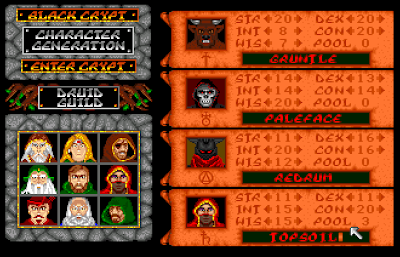 |
| Creating the four characters. |
The player creates four characters: a fighter, a cleric, a magician, and a druid. A pool of excess points is allocated among strength, intelligence, wisdom, and constitution. Names and portraits are chosen. Although some of the portraits are bestial or supernatural, they don’t seem to have any impact on gameplay. The process is quick, and the player finds himself on Level 1 of the starting dungeon within a few minutes. Each character begins with a melee weapon suitable to his profession and a little bit of food.
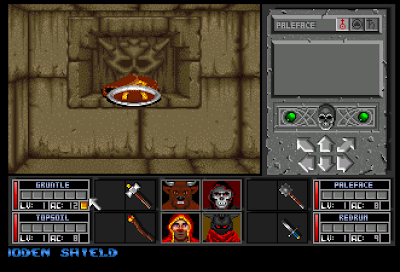 |
| Starting out. Right away, we find a shield and some food. |
In defiance of any sensible rules of capitalism, the creators included 30 “cluebook” pages in the game manual. Each dungeon level is fully detailed. I’m avoiding these pages, naturally, but I glanced at them long enough to see that the Black Crypt is a whopping 28 levels, the largest occupying coordinates up to 40 x 40. Fortunately, there are a lot of small levels, too. The game adopts the “worm tunnel” approach to mapping (meaning that there’s at least one square of “dead space” between adjacent walls), which also functionally shrinks the maps. Still, it’s a big game.
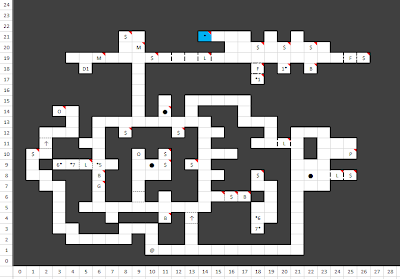 |
| Level 1 goes up to 26 x 21 but doesn’t use anywhere near all those tiles. |
The controls are okay. The game’s primary strength is allowing you to map your own movement options. This is the first time I remember such a setting appearing, and I’m grateful for it. When you have to play with one hand on the keyboard and the other on the mouse, neither arrow keys nor the numberpad make for a comfortable configuration. I re-mapped movement to WASD, which works a lot better. But aside from this customization and the use of F1-F4 to swap between character inventories, there’s no use of the keyboard. There are little annoyances like being able to enter a character’s inventory with F1 but then having to right-click to get back out, or being able to enter the disk menu with ESC but then having to click on the appropriate option to leave. There are still no keyboard options for executing attacks, which is something I’m always hoping for in Dungeon Master games.
One particular issue is going to dog me until late in the game and then probably screw me up for the next Dungeon Master-style game. The creators made it so you click on the character portrait to execute the primary attack rather than the weapon. Since Dungeon Master, Eye of the Beholder, and just about every other game does it the other way, I’m constantly clicking on weapons, which takes them out of the inventory slot so you can drop or trade them.
On the positive side, the inventory screens are well-organized. The lower-right corner has options for various containers: a backpack, a small chest, a large chest, a bag, and a quiver. You populate these spaces as you find the containers, then click on them to view their inventories. For wearable items, there are three screens, toggled by clicking the torso in the upper-right corner. The first has items of clothing, the second wearables like rings and belts, and the third the actual armor.
 |
| I face a locked door as I look at my fighter’s inventory. He has a chest, a backpack, and a bag. I have the chest open, and I’m looking at the armor screen that shows the outer armor. |
There’s a food and water system, and I suspect it’s going to be an annoyance until the cleric gets “Create Food.” The mechanic really doesn’t accomplish anything except impart a sense of urgency. If you want to explore carefully, you have to make a save, do your exploration and mapping, and then reload and cover the level faster, “for real.” But it’s worse than that because there’s only one meter to track both food and water, but the game clearly considers them separately in non-visible statistics. When you find a fountain, you can’t just gorge yourself on free water until the meter returns to its maximum because you need food, too. And if you don’t eat but only drink, the characters will start losing points for hunger even though the meter is nowhere near the bottom.
The first couple of levels were moderately-sized, going into the 20s on both axes. Combats were infrequent–maybe 15 enemies total on the two levels–and there were really only two types of enemies: giant worms, and giant worms capable of casting some kind of “Magic Missile”-like spell. Many of the classic Dungeon Master tricks work here, including attacking and then darting away before the enemy can respond, backpedaling down a corridor as you fire missile weapons, “waltzing,” and so forth. The famous “combat waltz” itself (check the glossary) seems a little harder here, it might just be a matter of getting used to a new game’s timing. Crypt keeps one annoying characteristic of Eye of the Beholder in which once an enemy casts a spell, you’re frozen until the animation completes.
 |
| The animation for the worms has them opening and closing their mouths. I only ever got screenshots when their maws were closed. |
What you can’t do–and this was a serious shock–is smash enemies in doors. That’s such a longstanding trait of Dungeon Master-style games that not including it borders on sacrilegious. I’m not sure if enemies can fall victim to other environmental effects or not. I haven’t encountered any others yet.
Killing enemies rewards you with traditional experience points, and levels increase automatically. I got to Level 4 on the first two levels. Leveling increases hit points and spell power, but otherwise there aren’t any choices. Attributes are increased by occasionally finding items that do so.
 |
| My druid levels up. |
Each spellcaster comes with Level 1 spells for their classes. Further levels must be found in spellbooks; you don’t get them upon leveling up. There are only 5 levels and only 4 spells per level. You can “prepare” up to four spells and then cast them by clicking on them in the slate. I find the system a bit easier than both Dungeon Master, where you had to remember runes in the middle of combat, and Eye of the Beholder, where you had to fiddle around with that little book. You also frequently find scrolls with multiple spells that can be cast in lieu of learning them.
Among the first two levels, I experienced a variety of navigation puzzles and other mechanisms that I’m sure will last throughout the game. These include:
- “Alcoves” with treasure stashed in them. These go back to Dungeon Master. Items can appear on the floor, too.
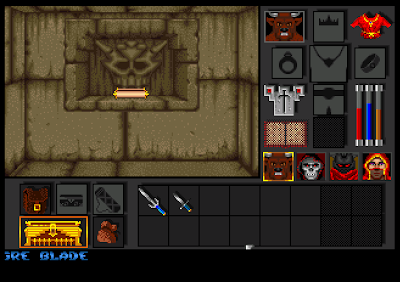 |
| I apparently found the Ogreblade here. |
- Messages in plaques on the wall. Some can only be read after the druid casts “Read Rune.”
- Scrolls that give you hints. But some of them are “false scrolls” and should be ignored. You can reveal these by casting the cleric’s “Reveal Truth,” which causes false scrolls to dissolve.
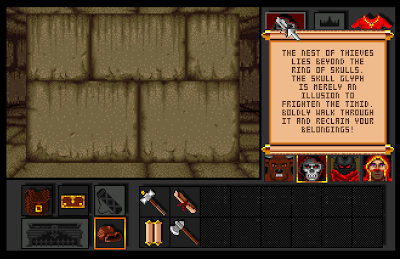 |
| This turned out to be a “false” scroll, but I think I could have figured that out. |
- Locked doors that only open with certain keys.
- Pressure plates that open walls.
- Spinners. There’s an obvious “transition” animation when you step on them, though, so it’s hard to get fooled.
- Force fields that require you to cast “Dispel” to pass them. You don’t have this spell at the outset, so you have to rely on found scrolls.
- Teleporters. They also have a clear “transition” animation.
- Buttons or switches that open secret doors or make pillars disappear.
- Buttons or switches that activate teleporters
- Buttons or switches that change the destinations of teleporters.
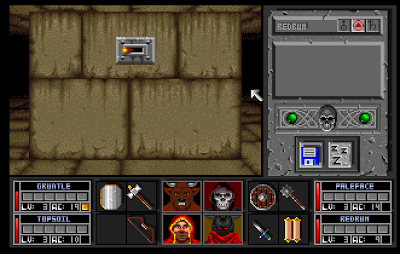 |
| It’s hard to tell what this will do. |
- Holes in the floor. Falling through them takes you to a lower level and causes damage.
- One-way walls.
- “Glyphs” in the middle of corridors that serve as traps. You have to cast “Remove Trap” on them.
 |
| Dispelling a glyph trap with a scroll. |
- Walls that open and close on a cycle.
- Doors that won’t open until you pass a copy-protection exercise.
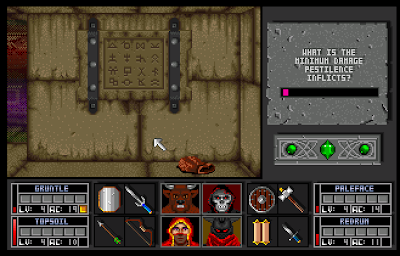 |
| The “copy protection” riddle breaks the illusion a bit. |
The second level had a two-headed ogre who is impossible to defeat with regular weapons (they don’t even hit him). A message on the first level warns you about him: “The one below is his own twin. Only a magic blade will pierce his skin.” This refers to an “Ogreblade” on the first level, though you have to get there via a teleporter on the second. (A “false” scroll warns you not to pick up the Ogreblade.) Until you find it, exploring the second level is tough because the ogre is constantly chasing you and pounding you to goo every time you pause for a few seconds. Once you have the sword, it doesn’t take long to kill him, and he drops the key necessary for the next level.
 |
| The ogre kills us as we try to crush him in the door. Apparently, you can’t do that in this game. |
Miscellaneous notes:
- The opening theme, which you can hear at the beginning of this video, is catchy. I found myself chair-dancing to it. It’s credited to Ken Schilder, who stayed with Raven and is credited on a couple dozen other titles. But it always surprises me that composers so often went with rock and techno themes for title music, when an older style would better fit the setting. There’s a “special topics” post in here some day.
- The fighter has an ability, activated by clicking on his “glyph” in the inventory screen, that tells your current coordinates. The glyphs are otherwise used to activate class-specific objects.
 |
| Checking my position. |
- A lot of the game’s messages are delivered as scrolling text at the bottom. It’s annoying and hard to screen-capture.
- The manual brags about making use of the Amiga’s “halfbrite” mode that apparently allows for more colors than normal. The Wikipedia page on the mode shows two photographs, and they look exactly the same to me. This is why I don’t talk about graphics that much.
- A trait that I wish the game hadn’t adopted from its predecessors: I have no idea the relative damage on different weapons. On the first two levels alone, I’m juggling hammers, warhammers, axes, and swords. Should I keep the Ogreblade–is it effective against non-ogres?–or dump it for a more conventional weapon? No idea. If the cluebook had that information, I wouldn’t be able to help but look at it.
- There’s an auto-map, available with the magic user’s “Wizard Sight,” but it shows so little detail that I can’t imagine not making my own maps.
Level 3 is patrolled by invisible enemies and a (true) scroll on the level warns you not to try to engage them until you’ve found the “Mask of Truesight” on a lower level. (A false scroll on the same level encourages you to attack the unseen enemies after removing all of your weapons and clothing.) Other than a couple of other locked doors, there wasn’t anything to do on the level, so I pressed on to Level 4.
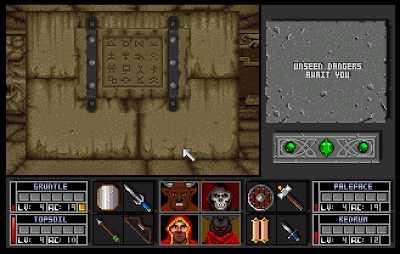 |
| This message wasn’t kidding. |
Remember the annoying gigglers in Dungeon Master? Well, Level 4 of this game has similar creatures who steal your stuff. Worse, they teleport away after stealing it, so you can’t chase them. I hope they turn up later in the level, or I’m out of shields.
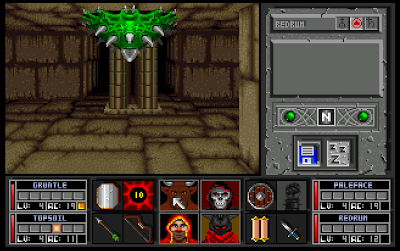 |
| Level 4 also has these monsters that walk on the ceiling. |
In the end, I suspect I’m going to find that the game is too long and too confining. I mean this not just in terms of physical space but also in character development. To require that the player have four specific classes and offer so few options in both creation and development largely means that every player arrives at the same place with essentially the same party. But for now, it’s fun enough, and with a dungeon crawler, you don’t waste a lot of time puzzling over your next move. It’s always the next unexplored square.
Time so far: 3 hours
***
I skipped Theldrow because I was having some emulation issues. I solved those after I got started with Black Crypt, so we’ll reverse the order and cover Theldrow next.
Original URL: http://crpgaddict.blogspot.com/2018/12/game-313-black-crypt-1992.html

